Voir les témoignages à propos de ce site
et donner le votre
Memospace site de partage de lieux historiques
Barbières
Vierge du voeu
Votive Virgin at Barbières, on a rock near a bridge at the edge of the village. The statue was inaugurated in 1923 in gratitude to the Virgin for her protection of the village, which was comparatively unharmed in World War I. After the Second World War, a "Grotto of Lourdes" was built in a nearby natural overhang. The grotto and stature were consecrated on September 7, 1947, by the Bishop of Valence, Camille Pic.
-=+=- -=+=- -=+=- -=+=- -=+=- -=+=- -=+=- -=+=-
There is dual origin for the statues of Votive Virgins, to be seen in a number of towns... Read more
Coordinates
- Monument
- Drome
- Local religious expression
Votive Virgin at Barbières, on a rock near a bridge at the edge of the village. The statue was inaugurated in 1923 in gratitude to the Virgin for her protection of the village, which was comparatively unharmed in World War I. After the Second World War, a "Grotto of Lourdes" was built in a nearby natural overhang. The grotto and stature were consecrated on September 7, 1947, by the Bishop of Valence, Camille Pic.
-=+=- -=+=- -=+=- -=+=- -=+=- -=+=- -=+=- -=+=-
There is dual origin for the statues of Votive Virgins, to be seen in a number of towns in Drôme. On July 9, 1944, in Die, Abbot Jean Bossan encouraged his parishioners to pray for the protection of the Virgin and to vow to build a statue in her honor if the town was saved. The Bishop of Valence-sur-Rhône, Monsignor Camille Pic, set in motion the movement in the département through the Religious Week of the diocese of Valence-sur-Rhône, Die and Saint-Paul-Trois-Châteaux on July 26, 1944. The vows would be taken on August 15, 1944, Assumption Day.
Making the statues was most often assigned to local or regional sculptors, such as Gaston Dintrat, the Hartmanns, refugees in Allex, Duilio Donzelli and his son Dante of Valence-sur-Rhône, the Bachini and Vermare shops from Lyon. The statues were of varied inspiration: crowned Virgins and child, uncrowned Virgins with or without haloes, Virgins of Lourdes, weeping Virgins, Virgins with a star, Virgins Our Lady of the Hearth. The list must be completed with statues from before 1944, that became votive Virgins afterwards.
Sources: "Semaine religieuse du diocèse de Valence, Die et Saint-Paul-Trois-Châteaux", 1947, p. 375 et 398 (MUV D 617 - ADD AP 55/15)
REVOL Hubert, "L'Echo et le Valentinois", 10 novembre 1987
Information: Jean-Noël Couriol
